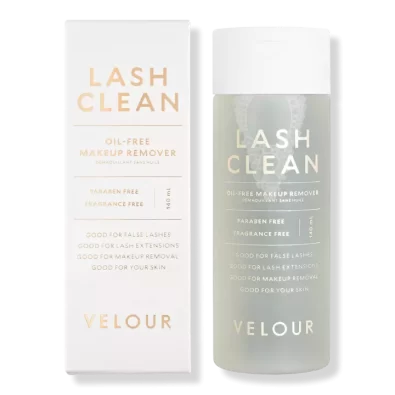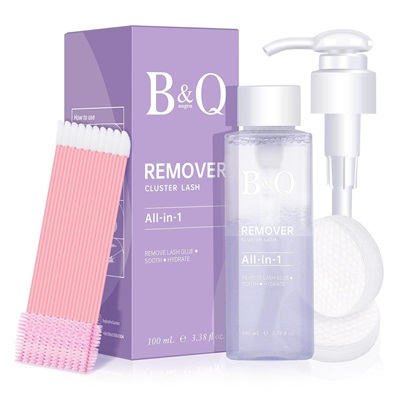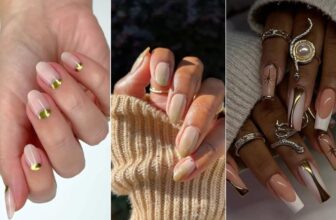A quick web search for “lash extensions” or “false lashes” yields numerous ads for local salons and compelling content about this popular beauty trend. Many women out there continue to seek longer and fuller lashes. However, there is a growing concern about the potential risks and dangers associated with this beauty enhancement. False lashes and extensions have the potential to cause damage to your natural lashes if not applied or maintained properly.
Beyond the risk of an allergic reaction to the glue used for attachment, there’s a potential danger of erosion on the inner surface of the eyelid, leading to permanent damage to your natural lashes. Whether opting for conventional glue-on lashes or investing in high-end salon extensions, the risks remain consistent.
This piece of content delves into the potential damage that fake lashes and extensions may inflict on your real lashes, exploring other associated risks and providing guidance on prevention.
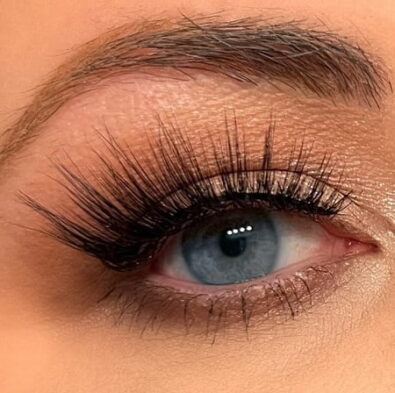
Can false lashes harm the natural ones?
Nowadays, the craze for false lashes is undeniable. Acting as a temporary enhancement, these lashes stick to the lash line using latex or acrylate-based adhesive. But is there a risk of damaging your natural lashes with falsies?
Here’s the good news: correctly applied fake lashes typically won’t harm your natural lashes at all! Issues arise only when excessive glue is applied or when the removal process becomes aggressive, potentially snagging and pulling out a few lashes.
Avoid the temptation to pull off the lashes forcefully during removal. Instead, gently peel them away using a makeup remover and a cotton swab. When used sparingly, adhesive shouldn’t compromise the integrity of your natural lashes. Opting for falsies instead of mascara might even contribute to healthier lashes!
There are theories about the weight of falsies causing potential issues for your real lashes, but in practice, dedicated falsie enthusiasts haven’t reported any significant problems.
Can lash extensions harm natural lashes?
Among the top queries for eyelash technicians is whether extensions hurt natural lashes. Depending on who you ask, the response could range from “it varies” to “possibly.”
The primary risk of eyelash loss often occurs during incorrect removal. Self-removal attempts heighten the chances of tugging on natural lashes, leading to potential loss.
Limited research exists on the impact of eyelash extensions on natural lashes. Some technicians speculate that post-removal, the lashes may seem sparser due to the contrast with the previously voluminous extensions.
While theories abound about potential lash damage from extensions, none are substantiated. The weight of extensions might stress lashes and inhibit growth temporarily, especially with voluminous styles. Improper cleaning leading to oil and debris buildup might also affect the hair follicle, though its impact on lash loss remains uncertain.
Fortunately, if extensions cause slight damage, lashes typically regenerate within a few months due to their regular growth cycle. Long-term risks, on the other hand, primarily revolve around skin allergies or infections, potentially damaging follicles and hindering future lash growth.
Further details on these risks are elaborated upon below.
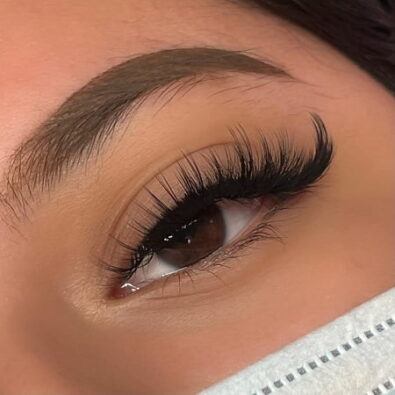
Additional Risks For Fake Lashes and Lash Extensions
When it comes to false eyelashes and extensions, there are additional risks to be mindful of.
False Eyelashes:
Similar to many eye makeup products, wearing false eyelashes comes with some health risks, but these are generally manageable with proper research and hygiene. The primary concerns include allergic reactions and infections.
Allergies often stem from lash adhesives, particularly those containing latex, though latex-free glues can also trigger reactions, albeit less commonly. Allergic responses may manifest as mild irritation along the lash line or, in severe cases, more intense reactions. Sharing falsies or neglecting thorough cleaning between uses elevates the risk of eye infections, potentially impacting long-term eye health.
Eyelash Extensions:
Eyelash extensions carry a slightly higher risk profile compared to false eyelashes, requiring skilled professionals for application. The most prevalent risk involves allergic reactions to the glue, often containing cyanoacrylate.
While these reactions are typically mild, severe cases may result in significant pain, redness, and swelling, potentially leading to severe eye or skin issues. Conducting a patch test with the adhesive beforehand is advisable.
Although allergies can be unpredictable, the likelihood of a reaction increases if the glue comes into direct contact with the skin, though this is rare with experienced lash technicians.
Commercial lash adhesives, such as those produced by Lilac St., often use gentler formulations, reducing the likelihood of aggravating allergies. Additionally, the risk of eye infection exists, particularly when dealing with less reputable salons that neglect proper hygiene practices.
Maintaining the beauty and safety of your falsies
Now that you know the risks that come with installing false lashes and extensions, let’s talk about how to maintain them for long-lasting beauty and overall safety.
Cleaning your lashes every day is not only a hygiene essential but also a key factor in extending their lifespan. Regular cleaning reduces the need for frequent salon visits, saving you money in the long run. Invest in high-quality, oil-free lash cleaners to protect the sensitive skin around your eyes.
Lashify and Velour offer excellent options, like Velour’s Lash Clean makeup remover and Lashify’s Melt Away Remover. Soak a cotton pad in these cleansers and gently rub your eyes, lashes, and lash lines to keep them clean, preventing crustiness and bacterial growth.
For maintaining the allure of your natural lashes, here are our recommendations for both false lashes and eyelash extensions.
Lash Clean Oil-Free Makeup Remover
B&Q Lash Cluster Remover
Tips for false lashes:
- Conduct a patch test of new lash glue on your forearm or behind your ear for a few days.
- If you have sensitive skin, consider avoiding latex-based adhesives.
- Gentle removal is key—peel off lashes with a make-up remover and a cotton swab.
- Disinfect false lashes with alcohol between uses.
- Preserve lash integrity by skipping mascara when wearing falsies.
Tips for eyelash extensions:
- Research and read reviews to choose a reputable lash technician or salon.
- Schedule a consultation and request a patch test for the extension adhesive.
- Opt for a lightweight, classic look for the first time to avoid weighing down your lashes.
- Follow the aftercare instructions from your lash technician to maintain cleanliness and groomed extensions.
- Never attempt at-home removal; always return to your lash technician for proper extension removal.
- If your natural lashes appear sparse, take a break from extensions for a few weeks.
Steps for a seamless falsie installation
While fake lashes can pose risks like eye irritation or infections, allergic reactions, and potential damage to natural lashes, many individuals successfully wear them without issues. Here are tips to ensure a damage-free and flawless application:
- Choose Your Technician Wisely:
Treat your lash appointment as you would a serious procedure like Botox. Opt for a technician with a portfolio of lashes that you admire. Before settling on a salon, request references and ensure the salon is certified.
- Seek Recommendations in Your Inner Circle:
Start by seeking recommendations from friends who have had positive experiences with salons. Personal referrals can guide you to reputable establishments.
- Verify Certifications:
Check the salon’s website for certifications, and don’t hesitate to look up your lash technician on state government websites for beauty industry licenses, such as those for estheticians and cosmetologists.
- Request Credentials:
Prioritize your health, and don’t shy away from asking your lash technician for their credentials. Your well-being is paramount, and any reputable professional will understand the importance of transparency.
By following these steps, you can enhance the likelihood of a safe and satisfying false lash experience. Your health and satisfaction are our top priorities.
Photo: Victor Silas/Pexels
You May Also Like:
Why Every Makeup Lover Needs a Spoolie Brush
December 15, 2025Quick Makeup Tips for Last-Minute Holiday Events
December 8, 2025SKIMS Beauty Just Announced Senegalese Diarrha N’Diaye as its New Executive VP
November 4, 2025Who Gets to Be Called Naturally Beautiful?
October 26, 2025The Rise of Henna-Inspired Nail and Makeup Trends
October 9, 2025The Secrets to Building a Beauty Brand
September 29, 2025Kylie Jenner Celebrates 10 Years of Kylie Cosmetics in a Power Pantsuit
September 18, 2025How African Beauty Representation Has Changed Over Time
September 18, 2025Kendall Jenner Breaks the Makeup Code: Revealing Her Secret to Big Lips
August 22, 2025Yemi Alade Reveals The First Makeup Products From Her Beauty Brand
August 18, 202510 South African Beauty Brands That Deserve a Spot in Your Routine
August 16, 2025Yemi Alade is Launching Her Own Beauty Line -YemBeauty
August 8, 2025Esther Ejoh is a Fashion Editor at Fashion Police Nigeria, where she writes all things fashion, beauty, and celebrity style, with a sharp eye and an even sharper pen. She’s the girl who’ll break down a Met Gala look one minute, rave about a Nigerian beauty brand the next, and still find time to binge a movie or get lost in a novel. Style, storytelling, and self-care? That’s her holy trinity.

